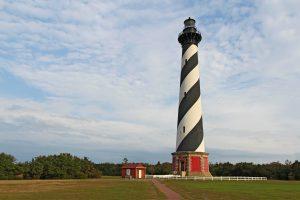
The Cape Hatteras Lighthouse in Buxton is an icon of the Outer Banks. Historically, the lighthouse was a lifesaver for mariners. Located on the Cape Hatteras National Seashore, the waters off the barrier islands have fast currents, which is excellent for shipping because they help vessels travel quickly. However, Diamond Shoals, a deadly area just offshore of Cape Hatteras, is where the fast-moving Gulf Stream Current runs into the cold Labrador Current, creating big waves and powerful storms.In these conditions, hundreds of ships have run aground — earning the area the nickname "Graveyard of the Atlantic." To save mariners and their cargo, in 1794 Congress authorized construction of the lighthouse. At 210 feet high, it is the largest brick lighthouse in the country and the second largest in the world. Diamond Shoals runs 10 nautical miles to the sea, and the beam from the tower is visible for 18 miles, giving ship captains plenty of warning to steer clear of the shoals.
If Towers Could Talk
The original was replaced in 1871 with a new tower and a light that was designed for higher visibility at sea. If the tower could talk, it would have plenty of stories to tell. In 1879, it was struck by lightning, and the masonry had to be repaired with metal rods. From 1942 to 1945 the lighthouse was used as a lookout for German U-boats (submarines). In 1999, erosion threatened the tower, and the structure was moved 2,900 feet inland. The current lighthouse survived the 1944 Great Atlantic Hurricane, and hurricanes of Category 3 or more, including Hazel, Connie, Ione, Helene, Donna, Diana, Emily, Fran, and Floyd.
Climbing the Lighthouse
It's easy to see why Outer Banks locals and visitors have such affection for the Cape Hatteras Lighthouse. It has not only stood as a sentinel over the sea but over history as well. Today you can climb the lighthouse on your visit and enjoy the incredible views from the top. The climb is strenuous, so be prepared for a workout.The lighthouse opens to the public the third Friday in April through Columbus Day, and is open daily from 9 a.m. to 4:30 p.m. Tickets are $8 for adults and $4 for senior citizens, children, and the disabled. Climbs run every 10 minutes with a limit of 30 people per climb.There are 257 steps, the equivalent of walking up the stairs of a 12-story building. It can be hot and humid, so it may not be the right activity for those with some medical conditions.If you plan to climb, there are a few rules:
- Climbers must be 42" tall and everyone has to be able to walk on his or her own up and down the stairs.
- Children under 11 must climb with someone at least 16 years old.
- You must wear flat shoes.
- No one can be carried, so this is not an activity for very young children.
- No eating or drinking (except water).
- No pets.
- No backpacks, beach bags, or coolers.
Full Moon Tours
For a real treat, time your visit to the Outer Banks during a full moon and reserve your spot on a Full Moon Tour. Tours take place once a month during May, June, July, August, and September. The lighthouse is dim inside even during the day, so if your child is afraid of the dark or someone in your party is claustrophobic, this may not be their favorite activity.If you're okay climbing 257 steps on a narrow, dim, spiral staircase, you'll be rewarded with the beautiful spectacle of the full moon appearing to rise from the Atlantic Ocean. Visitors describe the experience as breathtaking, and slightly eerie as time seems to roll back a century on those full-moon nights.
Photo Ops Abound
As one of the most-photographed icons in the Outer Banks of North Carolina, the Cape Hatteras Lighthouse draws shutterbugs from around the county. Tuck your camera (or smartphone) into your bag as you head off to explore.If its classic black-and-white daymark isn't enough to catch your eye, the red-brick base will be. You'll find 360 degrees of inspiration from the light keeper's house and museum to the waves lapping onto the shore.Share your shots online or have them printed and framed as a constant reminder of the memories you and your family made during your tour.Pro tip: Spring and summer are mosquito season in the Outer Banks, so take bug spray and consider wearing lightweight long pants and a long-sleeved shirt.Visiting the Cape Hatteras Lighthouse during the day or at the full moon is a memorable experience that you won't want to miss during your visit to the Outer Banks.
 The Cape Hatteras Lighthouse in Buxton is an icon of the Outer Banks. Historically, the lighthouse was a lifesaver for mariners. Located on the Cape Hatteras National Seashore, the waters off the barrier islands have fast currents, which is excellent for shipping because they help vessels travel quickly. However, Diamond Shoals, a deadly area just offshore of Cape Hatteras, is where the fast-moving Gulf Stream Current runs into the cold Labrador Current, creating big waves and powerful storms.In these conditions, hundreds of ships have run aground — earning the area the nickname "Graveyard of the Atlantic." To save mariners and their cargo, in 1794 Congress authorized construction of the lighthouse. At 210 feet high, it is the largest brick lighthouse in the country and the second largest in the world. Diamond Shoals runs 10 nautical miles to the sea, and the beam from the tower is visible for 18 miles, giving ship captains plenty of warning to steer clear of the shoals.
The Cape Hatteras Lighthouse in Buxton is an icon of the Outer Banks. Historically, the lighthouse was a lifesaver for mariners. Located on the Cape Hatteras National Seashore, the waters off the barrier islands have fast currents, which is excellent for shipping because they help vessels travel quickly. However, Diamond Shoals, a deadly area just offshore of Cape Hatteras, is where the fast-moving Gulf Stream Current runs into the cold Labrador Current, creating big waves and powerful storms.In these conditions, hundreds of ships have run aground — earning the area the nickname "Graveyard of the Atlantic." To save mariners and their cargo, in 1794 Congress authorized construction of the lighthouse. At 210 feet high, it is the largest brick lighthouse in the country and the second largest in the world. Diamond Shoals runs 10 nautical miles to the sea, and the beam from the tower is visible for 18 miles, giving ship captains plenty of warning to steer clear of the shoals.








